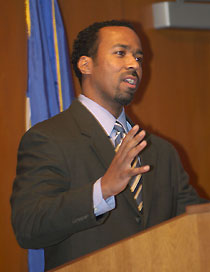|
This is an archived article. For the latest news, go to the Advance Homepage
For more archives, go to the Advance Archive/Search Page. |
||
|
FIfty Years After Landmark Ruling,
Not all is golden on the 50th anniversary of Brown v. Board of Education. That was the verdict of a panel of current and former UConn faculty members, during a discussion of the 1954 landmark U.S. Supreme Court decision that ruled the doctrine of a "separate but equal" public school education was unconstitutional. The panel, organized by the African American Cultural Center as part of Black History Month, was held on Feb. 16 in Konover Auditorium.
While there was agreement that the decision was a turning point in American history, there was also consensus that much remains to be done to eliminate barriers that still separate Americans, whether in Topeka, Kan., where the celebrated case originated, or in the South, where segregation's grip held tight for decades, or even in Connecticut. "Brown rebuked a government-sanctioned black inferiority," said Professor Ronald Taylor, a sociologist and vice provost for multicultural and international affairs. But progress in turning the court ruling into reality has moved at a glacial pace. Taylor said Thurgood Marshall, one of the attorneys for Brown and later a renowned Supreme Court justice, thought segregated schools would be eliminated within five years. "Boy, was he wrong," Taylor said. Brown's "promise is not yet fulfilled," he added, "but the potential is there." Richard Schwab, dean of the Neag School of Education, quoted from the court decision and then asked rhetorically, "Do all kids have an equal shot at getting a quality education?" His response, using data provided by Education Trust and the National Commission on Teaching and America's Future, pointed to a disturbing trend wherein the gaps in test scores between white and African American students, which had narrowed up until about 1990, were now actually widening. Schwab said the biggest factors were not race or economic status, citing examples of schools in minority and low-income areas that were among the highest-performing in their states. "The most important thing, the key factor, is great teachers," he said. "Not all kids are getting an equal shot at highly qualified teachers." Schwab said it is clear that ineffective teachers hurt students, and the cumulative effect of several years of bad teachers can produce an achievement gap that can never be made up. Alexinia Baldwin, a retired professor and former department head of curriculum and instruction in the Neag School, began as she called it, "Bombingham" - during the post-Brown era. She described a city where segregation died hard, with black children still required to travel past white schools to their own buildings years after the decision. But the civil rights movement was advancing on many fronts. "I taught the first class of black gifted students" in Birmingham, she said. After the black students did as well as, or even better than, their white counterparts, three black students were allowed to transfer into an all-white class. "Changes have been slow to come," she said of the legacy of Brown. "The discussion is ongoing." Separate societies were not restricted to the South, nor did they end in the 1960's. Dr. Jeffrey Ogbonna Ogbar, an associate professor of history and director of the Institute for African American Studies, described growing up in an all-black Chicago neighborhood. He spoke of a "social distance" that kept the races apart, a lack of interaction that continues today in many parts of the country. This separation persists in the communities and schools of Connecticut. Taylor said most white students come to UConn from suburbs and small towns, while many of the black students are from urban areas. He said there is often little interaction between whites and blacks. "Most white students have had little experience with people who look like me," he said. "I've been the first faculty member of color for many of my white students. Schwab said it is essential to attract more minority students into teaching, and also to get talented teachers of any color to consider working in urban districts. Neag students spend considerable time training in Hartford, Stamford, and Willimantic schools. Some 11 percent of UConn's current education majors are minorities, a figure Schwab is working hard to increase. "We need a bigger pool of kids in college from diverse backgrounds to pull from," he said. Although the number of students of color at UConn is increasing, they are still in a minority. Taylor said many black students, coming from schools where the student body was almost exclusively black, find this disconcerting. "Black students find UConn very scary," he said. "They are not a majority anymore. For white students, it's a continuation of their experience. "The challenge is to bring students together from different backgrounds," he added. "Fortunately, the vast majority of people who work here do care, and want to make this a welcoming environment." |

